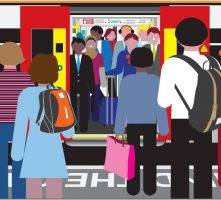September 2, 2016
Younger people less keen on recycling at work, especially coffee cups 0
 The younger generation have a reputation for being pretty keen on addressing environmental issues, but new data alleges they’re not as open to changing their behaviours. There’s actually a clear generational gap when it comes to attitudes towards recycling at work and it’s the older generation who make more effort, a new survey suggests. It claims that younger people are around 16 percent less likely to recycle at work with just 64 percent of people aged 18-24 prepared to adhere to their employers’ recycling policies. One particular cause of concern is the fact that 2.5 billion coffee cups are thrown away each year, leading the Liberal Democrats to recently call for action to be taken to address the fact that only one in 400 cups are recycled. The survey, which was carried out by commercial waste recycling services provider Direct365, claims that 72 percent of people do actually recycle items at work overall.
The younger generation have a reputation for being pretty keen on addressing environmental issues, but new data alleges they’re not as open to changing their behaviours. There’s actually a clear generational gap when it comes to attitudes towards recycling at work and it’s the older generation who make more effort, a new survey suggests. It claims that younger people are around 16 percent less likely to recycle at work with just 64 percent of people aged 18-24 prepared to adhere to their employers’ recycling policies. One particular cause of concern is the fact that 2.5 billion coffee cups are thrown away each year, leading the Liberal Democrats to recently call for action to be taken to address the fact that only one in 400 cups are recycled. The survey, which was carried out by commercial waste recycling services provider Direct365, claims that 72 percent of people do actually recycle items at work overall.
















 It is no longer a question of whether one of the world’s major economies will introduce a universal basic income for all of its citizens, but when. Over the weekend, the leader of the UK’s Labour Party Jeremy Corbyn announced in
It is no longer a question of whether one of the world’s major economies will introduce a universal basic income for all of its citizens, but when. Over the weekend, the leader of the UK’s Labour Party Jeremy Corbyn announced in 
 We’re operating in an increasingly tech-centric environment, but human talent still remains one of the core differentiators if a business is to thrive. Not surprisingly, the mission to get the very best people on board and optimise the potential of those already in situ has become the Holy Grail for many companies, irrespective of scale and sector – a challenge that demands a more intuitive and precise, even scientific approach to human capital management. Data analytics is a case in point, designed to extrapolate insight from intelligence across a variety of disparate sources and establish actionable intelligence, capabilities which naturally lend themselves to powering key decisions around hiring and retention and building on existing talent. Yet despite the proliferation of analytics across many strands of the workplace, take up in the HR sphere remains relatively modest, in tandem with a long-held reticence over the use of the technology in this area.
We’re operating in an increasingly tech-centric environment, but human talent still remains one of the core differentiators if a business is to thrive. Not surprisingly, the mission to get the very best people on board and optimise the potential of those already in situ has become the Holy Grail for many companies, irrespective of scale and sector – a challenge that demands a more intuitive and precise, even scientific approach to human capital management. Data analytics is a case in point, designed to extrapolate insight from intelligence across a variety of disparate sources and establish actionable intelligence, capabilities which naturally lend themselves to powering key decisions around hiring and retention and building on existing talent. Yet despite the proliferation of analytics across many strands of the workplace, take up in the HR sphere remains relatively modest, in tandem with a long-held reticence over the use of the technology in this area.
 Fifteen million UK internet users have undertaken a ‘digital detox’ in a bid to strike a healthier balance between technology and life beyond the screen, according to a new Ofcom study. The study of around 2,500 people suggests that our reliance on the internet is affecting people’s personal and working lives, leading many to seek time away from the web to spend time with friends and family. Ofcom’s
Fifteen million UK internet users have undertaken a ‘digital detox’ in a bid to strike a healthier balance between technology and life beyond the screen, according to a new Ofcom study. The study of around 2,500 people suggests that our reliance on the internet is affecting people’s personal and working lives, leading many to seek time away from the web to spend time with friends and family. Ofcom’s 










August 17, 2016
Intelligent lighting can enhance workplace wellbeing and productivity 0
by Andy Gallacher • Comment, Environment, Facilities management, Lighting, Wellbeing, Workplace design
(more…)